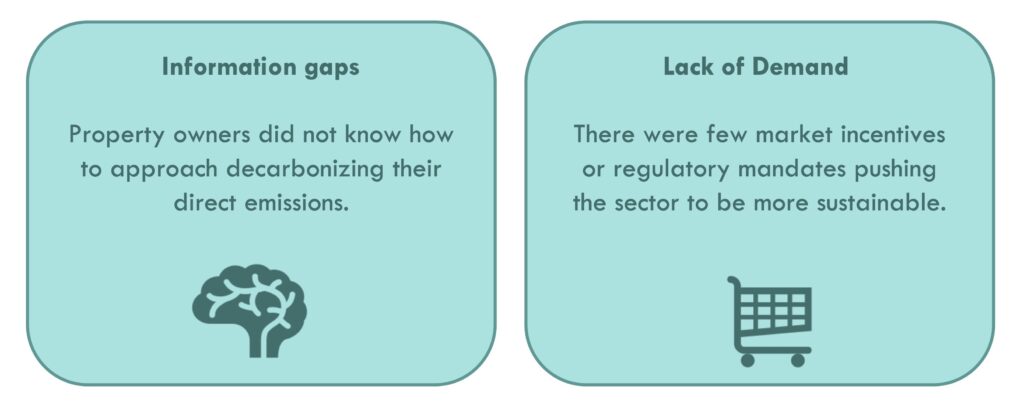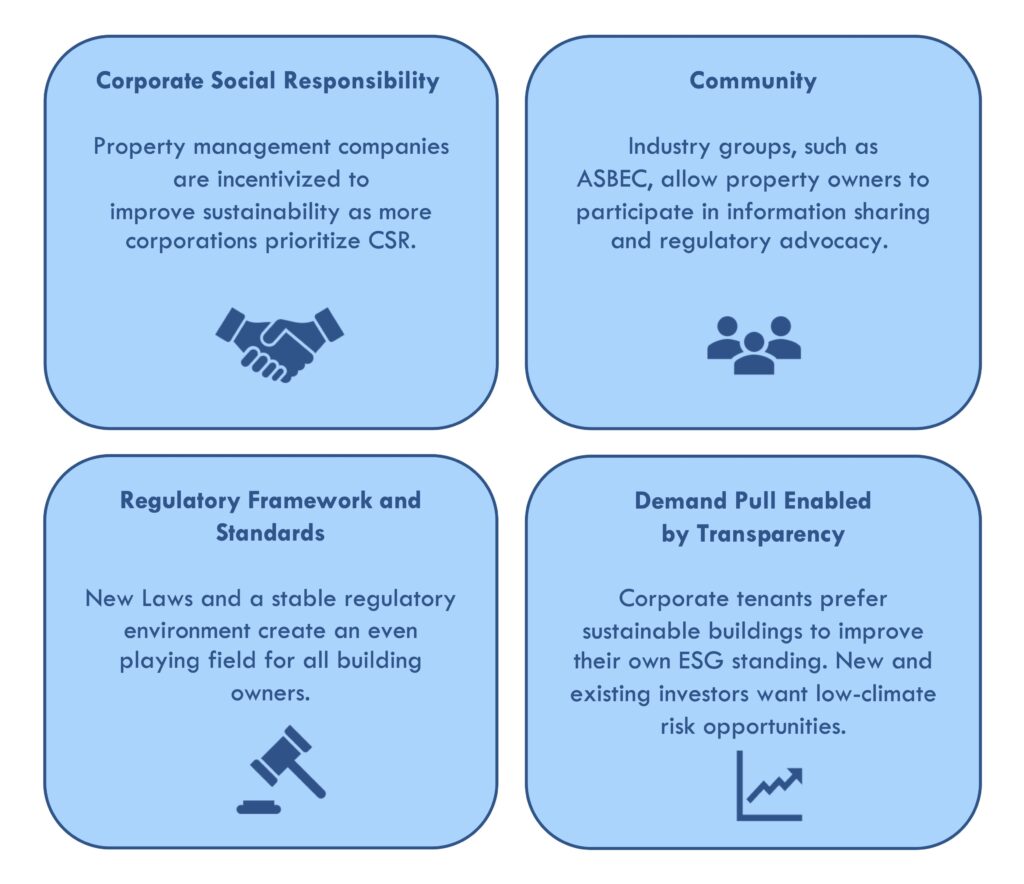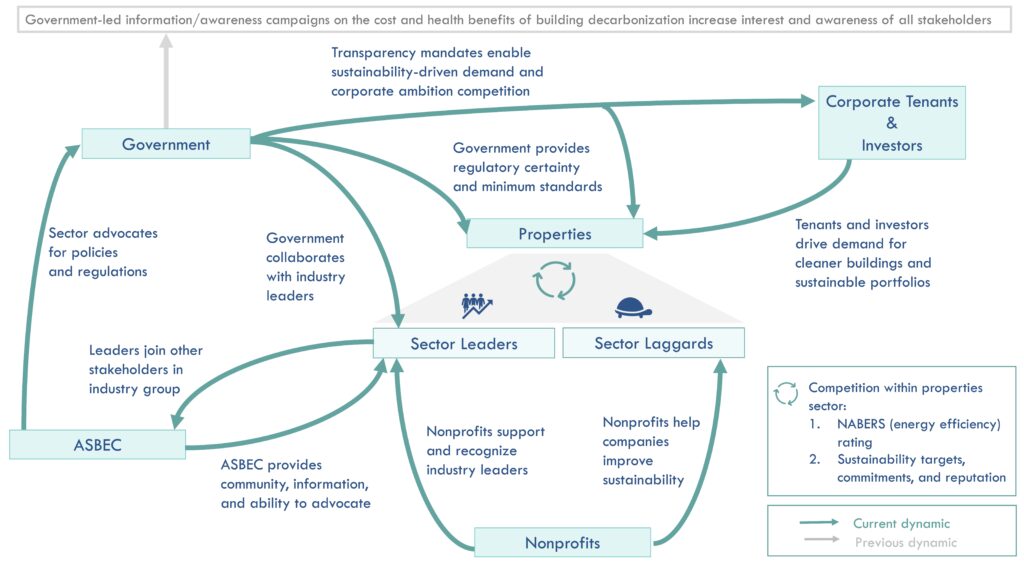
How Australia is Decarbonizing Its Premium Commercial Buildings: A Story of Ambition Loops
We thank Climateworks Centre for being a valuable contributor to this piece.

Currently, more than half of the largest commercial property management companies in Australia have climate goals that are fully or closely aligned with the country’s net zero by 2050 target. This makes Australia one of the leading countries worldwide when it comes to property management commitments. This case study describes how Australia became a leader in decarbonizing high-end commercial buildings. The secret lies in ambition loops.
Exhibit 1. According to the Australian government’s National Energy Productivity Plan 2015–2030, decarbonization of the commercial buildings sector is expected to account for a quarter of energy related emissions savings by 2030.
Ambition loops occur when corporations, cities, and financial institutions take action on climate-related goals. The positive feedbacks these key actors collectively generate in the economy, such as decreasing costs of new technologies and increasing demand in sustainably produced energy, inspire and motivate even faster action on climate-related goals.
Public and Private Leadership
Long before widespread climate ambition in the sector, the Victoria state government set higher environmental standards for its building procurement, catalyzing early progress within the premium commercial properties market. The government also led information campaigns, educating the public and industry on the cost and health benefits of electrification and decarbonization. In addition, nonprofit organizations called for better environmental standards and air quality, and supported sustainability efforts with techno-economic research.
Sector leaders also began aligning on sustainable priorities under the auspices of the Australian Sustainable Built Environment Council (ASBEC), an industry group representing the interests of all stakeholders in the buildings sector. These early-stage efforts paved the way for large private sector leaders to ramp up climate ambition.
Key Barriers Faced by Property Managers
Exhibit 2. Information gaps and lack of demand were the two main barriers faced by the commercial properties sector. Exhibit by RMI.
But these leaders faced barriers in realizing their ambition. As the first region to attempt large-scale building decarbonization, there were major knowledge gaps that needed to be filled on how to approach large-scale decarbonization of buildings, such as technology options and financing retrofits. Additionally, other than government procurement, there were few legal or market incentives driving demand for decarbonization. For example, there were no initiatives such as green building standards and certifications that when used widely allowed stakeholders to make informed decisions.
A Set of Incentives Catalyzed Sector Decarbonization
Exhibit 3. Increases in corporate social responsibility (CSR), community input, regulation, and demand have incentivized property management companies to increase sustainable ambition. Exhibit by RMI.
However, the government now prioritizes and rewards corporate sustainability and decarbonization. This has added relevance to organizations that champion sustainability and engage with key stakeholders. In addition, ASBEC has continued to provide the industry with a collaborative community for knowledge sharing and a platform for policy advocacy.
Regulatory frameworks and standards implemented over the past few years incentivize ambition and force laggards in the sector to improve along with their peers. There are two primary regulatory mechanisms at play. First, mandatory standards, such as building and construction efficiency codes, require the entire sector to compete on an even playing field, as no actor is financially set back for undergoing retrofits or other costly improvements. These initiatives have improved the least sustainable companies in the industry.
The second mechanism rewards leaders for environmentally friendly properties. Since November 2011, the Commercial Building Disclosure Program has required large building managers to share their energy efficiency information with prospective corporate tenants. And a voluntary program, The National Australian Built Environment Rating System (NABERS), provides buildings with simple sustainability scores.
These transparency initiatives have increased demand for sustainable buildings and stimulated additional competition among leading property management companies. Corporate tenants concerned about their own operating emissions prefer to work in buildings that match their sustainability goals. And investors, who continuously place a higher value on sustainability, prefer building portfolios that maintain lower carbon emissions. This demand pull creates a continuous incentive for increased ambition among premium commercial building owners.
Together, the interplay between all stakeholders, including the government, nonprofits, ASBEC, property owners, and the building sector at large, has resulted in positive feedback loops of increasing ambition.
Government Regulation, Nonprofits, Investors, and Tenants Were Pivotal in Driving Decarbonization in the Sector
Exhibit 4. Major ambition loops are driven by transparency and regulation from the government, advocacy from sector leaders via ASBEC, and efforts from nonprofits. Exhibit by RMI.
Exhibit 4 shows the dynamics between stakeholders in the commercial properties space that have continuously accelerated the sector toward decarbonization. Environmental nonprofit organizations have provided industry leaders with research and evidence supporting their arguments for decarbonization. Tools such as Climateworks Centre’s Net Zero Momentum Tracker rank commercial property portfolios, recognizing those doing well and incentivizing those doing poorly to improve.
Through ASBEC, sector leaders have collaborated with the government and advocated for efficiency standards that level the playing field for all large property management companies. The government was able to provide transparency and efficiency rating regulations to the industry, furthering decarbonization and electrification. Early on, the information and awareness campaigns convinced stakeholders and the public that cleaner buildings are important for financial savings and human health. Armed with information and transparency about sustainability in the sector, tenants and investors have been able to utilize their market power to choose clean buildings and portfolios.
Now, peers within the sector compete against each other to set better climate targets and improve sustainability thereby attracting more tenants, raising investment capital, and benefiting from good CSR reputations.
The Best Is Yet to Come
The dynamics observed in the commercial properties sector in Australia is a strong proof point of ambition loop dynamics. It is an example of the role the government can play together with sector leaders and NGOs in early formation of these feedback loops. The government of New South Wales has plans to expand the NABERS rating system to include embodied carbon (emissions created from building construction) metrics. Complete decarbonization of Australia’s building sector is dependent on the success of this program and others.
The success of premium and A-grade buildings in the commercial properties sector has driven sustainability regulations in the residential and construction industries in Australia. The regulatory and stakeholder obstacles overcome by the commercial properties sector have also made it easier for sector leaders elsewhere to catalyze change. NABERS has expanded to New Zealand and the UK, providing a third-party environmental rating system to entire building stocks. And, energy use transparency between building owners and tenants or prospective buyers is required in the UK and Germany. As Australia moves closer to a fully decarbonized commercial building stock, it is expected that other regions and sectors will follow its lead.


